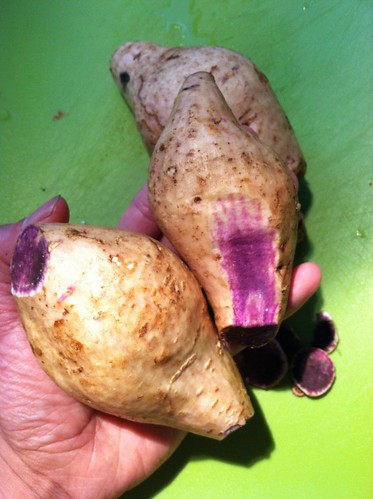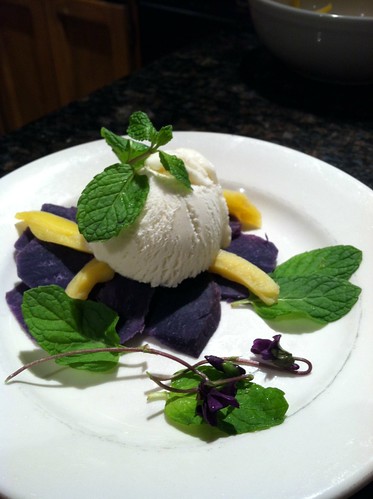This is an update from the original post way back in February of 2012. If you read the comments below, I was clearly incorrect and I've decided to edit this post so it clears up the confusion now that I have a better understanding.
R
--------------------------------------------------------------------------
A few weeks back, I found these wonderful tubers that reminded me of my homeland at a local Asian market. At first glance, I immediately thought I had found "Ube" (pronounced OO-beh) AKA the "purple yam". I instantly raved, mentioned it to my family and immediately blogged about it.
But to my disappointment (and slight embarrassment), what I actually bought, which was actually labelled as "PURPLE YAM" is actually a PURPLE SWEET POTATO!
  |
| (L) Fresh roots of Ipomoea batatas 'Okinawan Purple' aka Purple Sweet Potato sliced to expose the purple flesh and (R) the cooked potatoes. |
Much like the confusion between SWEET POTATOES VS. YAMS during the holiday cooking seasons at the grocery stores, I basically fell for the same thing not truly knowing the difference between the two. THEY ARE NOT TECHNICALLY THE SAME! Here's a link that clears it up and explains where the confusion began!
First off, true "UBE" is rarely available fresh here in the temperate climate:
UBE or purple yam is A TRUE YAM and botanically known as Dioscorea alata
This beautiful root crop is a very popular starch in the Philippines and I often craved it as it was the main ingredient in many of my favorite childhood snacks and desserts.
It has a lovely smooth texture, a stunningly beautiful flesh that's deep violet when cut into raw and turns a smokey deep purple and has a wonderfully sweet, starchy flavor that's baked or roasted like a baked potato. It is also made into a sweet paste that's used to flavor cakes, sweet porridge, and added to make the famous Halo-halo: a super sweet dessert consisting of fresh and preserved tropical fruits topped with shaved ice, ice cream, a dollop of ube, and condensed milk with sugar.
Now what I have pictured above is Ipomoea batatas, the true Sweet Potato we all know and love and is sometimes incorrectly referred to as a yam. So, of course, when I saw the PURPLE VARIETY OF SWEET POTATO, I immediately thought it was the tubers of the Ube because the market labelled it as "PURPLE YAM".
So here's where the lightbulb really clicked on: Both the true Ube Yam and Purple Sweet Potato produce the same colored/textured cooked flesh and they're both sweet!! I'm sure there are more obvious differences in terms of intensity of flavor and such, but it's very easy to assume and call one thing the other. And I'm sure Purple Sweet Potato is often substituted for true Purple Yam
While it's kind of cold to have Halo-halo during the winter, I played around in the kitchen with the tasty PURPLE SWEET POTATO and came up with this pretty presentation:
 |
| Roasted Purple Yam topped with jackfruit and vanilla ice cream garnished with mint and sweet violet blossoms. |
So, to the gardeners out there. The same "Sweet Potato Vine" that we love to use for annual bedding, window-boxes, hanging baskets and containers is the SAME SPECIES of sweet potato that I bought and the same species many people eat! If you ever take apart an annual planting, you'll often find the fleshy tubers that the vines have formed! These are perfectly edible (organically grown ideally), but just more ornamental in foliage than the sweet potatoes actually farmed for their sweet tubers!
Both Dioscorea alata and Ipomoea batatas are both warm weather plants we can't really grow very well here in the Pacific Northwest (for the tubers) due to our lack of heat, humidity and a lack of a long growing season. However, I've heard of several gardeners in different parts of WA State and also in the Portland, OR region that have had success growing great sweet potato TUBERS from easy season "slips" or young rooted cuttings that are planted as soon as the soil warms up. The true YAM, however, I've never really seen growing outside of greenhouse facilities and it's usually a different species.
I hope this clears up the confusion. Now we all know what we're actually buying and EATING!
Cheers,
R
What an artfully concocted ice cream creation.
ReplyDeletenellie
Thank you, Nellie!
ReplyDeleteVery nice website. It makes me want to grow my own ube. Can I ask you where I can obtain some ube plants to start growing? Thank you for your time.
ReplyDeleteRick
ram03@windstream.net
thats not a pic of Dioscorea alata but Ipomea battatas , probably okinawan purple , not botanically related and very different taste
ReplyDeleteprettey and tasty , but not the same
Thanks for that correction!! It was pretty confusing as I was told by the vendors it was "Ube" so I just assumed that it was Dioscorea. Maybe most Filipinos think that this Okinawan Purple Yam is ube because they want it to be. Hhahahaha
ReplyDeleteI better seek out the true Ube and compare next winter. Most of the "ube" we get is processed in a jar ready to use.
Thanks again!
I have several ube plants for sale. Feel free to email me at palengke97@gmail.com if interested. Thanks
ReplyDelete>.< that's not an ube.. ube's skin when washed with water is also color purple. i know coz im growing one. >3< but the one in the picture is also delicious.
ReplyDeleteThis is the correct ube: Dioscorea alata
ReplyDelete